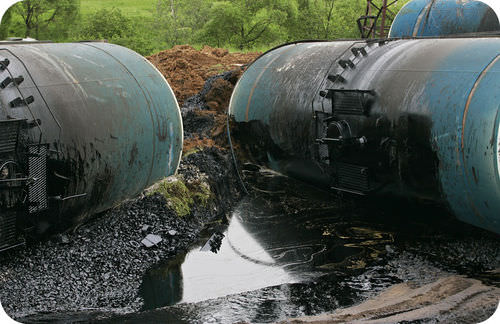8.19: Groundwater Pollution
- Page ID
- 5457
How could the water in this well be polluted?
Such an idyllic scene. The water from the well must taste as fresh as the springtime air. Of course, the water may be contaminated. Industrial waste from a factory down the road, or any number of other things, could have polluted the aquifer.
How Pollutants Enter Groundwater
Groundwater pollutants are the same as surface water pollutants: municipal, agricultural, and industrial. Groundwater is more susceptible to some sources of pollution. For example, irrigation water infiltrates into the ground, bringing with it the pesticides, fertilizers, and herbicides that were sprayed on the fields. Water that seeps through landfills also carries toxins into the ground. Toxic substances and things like gasoline are kept in underground storage tanks; more than 100,000 of the tanks are currently leaking and many more may develop leaks.
Tanks may break and leak whatever toxins they contain into the ground.
Filtered Water
Groundwater is a bit safer from pollution than surface water from some types of pollution, because some pollutants are filtered out by the rock and soil that water travels through as it travels through the ground or once it is in the aquifer. Rock and soil can’t get out everything, however, depending on the type of rock and soil and on the types of pollutants. As it is, about 25% of the usable groundwater and 45% of the municipal groundwater supplies in the United States are polluted.
Pollutant Plume
When the pollutant enters the aquifer, contamination spreads in the water outward from the source and travels in the direction that the water is moving. This pollutant plume may travel very slowly, only a few inches a day, but over time can contaminate a large portion of the aquifer. Many wells that are currently in use are contaminated. In Florida, for example, more than 90% of wells have detectible contaminants and thousands have been closed.
Further Reading
Cleaning Up Groundwater
Summary
- Groundwater is susceptible to pollutants that infiltrate into the ground from underground storage tanks or agricultural fields.
- Rock and soil filters some pollutants as water travels down to and through an aquifer.
- A plume containing pollutants travels outward from the source and through the aquifer in the direction the water is moving.
Review
- Is groundwater always cleaner than surface water?
- Is water that is advertised as spring water necessarily free of contaminants? Why or why not?
- How does groundwater move into and through an aquifer?
Explore More
Use this resource to answer the questions that follow.
- What chemicals get into drinking water?
- How does water get into the groundwater aquifer?
- How does rock dissolve?
- How does karst aquifers groundwater get contaminated?
- What are the three types of contaminants?
- What happens to these contaminates when it rains above a karst aquifer?
- What do sediments increase pollution in an aquifer?



